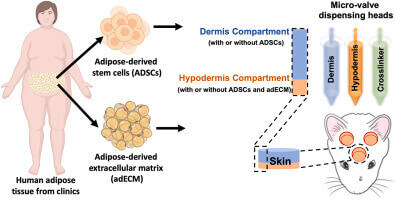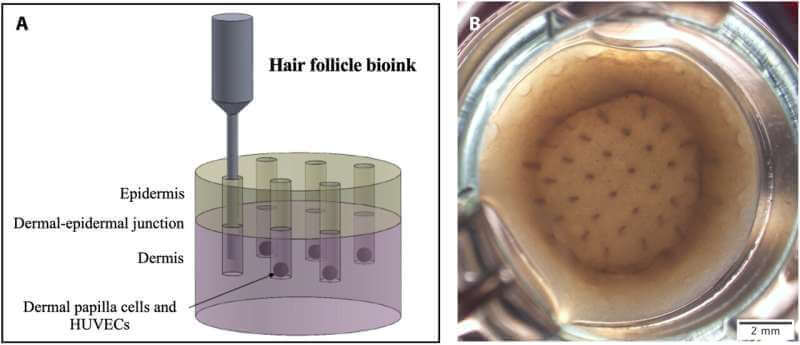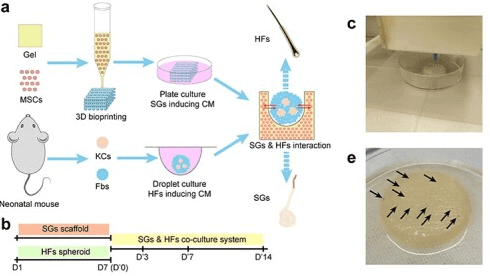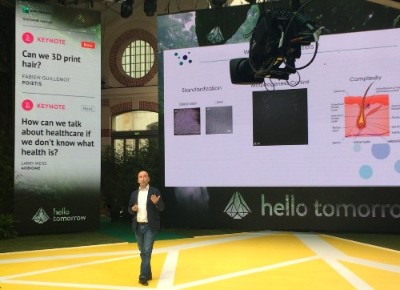Within the world of 3D bioprinting, the most exciting developments to look forward to involve the 3D printing of essential human body parts. However, for us hair loss sufferers, 3D bioprinted hair is of foremost interest.
Note that there are various 3D printing technologies with different purposes. These include: bioprinting of hair follicles that would then be transplanted; bioprinting of skin that also contains hair and sweat glands; 3D printing of scaffolds to assist in 3D culturing of hair and dermal papilla cells; and 3D printing of hair systems.
March 21, 2024
University of Oregon (US) researchers have teamed up with scientists from L’Oréal (France) to develop a multilayered artificial skin that more accurately mimics real human skin. Their research on tailored skin tissue engineering was published on March 7 in the journal Advanced Functional Materials. The artificial skin can be grown in just 18 days and relies on a novel 3D printing technique. Most importantly, these skin models have the potential to be safely transplanted into humans in future. This would paved the way for personalized skin grafts for burn victims and patients with skin diseases.
March 1, 2024
3D-Printed Skin Closes Wounds and Contains Hair Follicle Precursors

In a new study led by Dr. Ibrahim Ozbolat and other scientists from Penn State University (US), the researchers managed to bioprint skin as well as hair in rats in a unique way using adipose (fat) cells. The full study can be read in the latest issue of Bioactive Materials. One of the co-authors is Ryan Driskell from Washington State. I covered his work and unique skin related website in my post on skin regeneration, wound healing and hair growth.
The researchers obtained fat cells and tissue from patients undergoing surgery at a nearby hospital. They then used this tissue to correct injuries in rats via the use of a 3D printer. They also obtained adipose-derived stem cells (ADSCs) and adipose-derived extracellular matrix (adECM) from the adipose tissue to make another bioink component.
While scientists have previously 3D bioprinted thin layers of skin, the Penn team are the first to intraoperatively print a full, living system of multiple skin layers. This includes the lowest layer hypodermis, which is below the epidermis and dermis. The ADSCs and ECM also induced downgrowth of hair follicle-like structures.
According to Dr. Ozbolat:
“We are working to advance this, to mature the hair follicles with controlled density, directionality and growth. We believe this could be applied in dermatology, hair transplants, and plastic and reconstructive surgeries.”
November 16, 2023
3D Bioprinting of Hair Follicles within Skin

A team of scientists from Rensselaer Polytechnic Institute (US) has 3D-printed hair follicles in human skin tissue cultured in the lab. The research was published in Scientific Advances in October 2023 and led by Dr. Pankaj Karande.
December 21, 2022
New Studies on 3D Bioprinting of Hair Follicles
I am updating this post due to several new studies on 3D bioprinting of hair follicles.
- A new December 2022 paper from China concludes that a new bead-jet enabled printing of mesenchymal stem cell laden Matrigel beads results in hair follicle regeneration. Matrigel (similar to extracellular matrix) was selected as the biomaterial for this research. Compared with conventional 3D in-situ printing techniques, bead-jet printing is specialized for stem cell therapy, with improved retention rates. The new technology might find a diverse range of uses in clinical applications for regenerative medicine.
- A November 2022 paper from China discusses an interesting mechanical engineering approach of “in situ” bioprinting. The scientists printed bioinks directly into defective sites in order to promote tissue repair. Epidermal stem cells (Epi-SCs), skin-derived precursors (SKPs), and Matrigel were “printed” into the wounds of nude mice to promote hair follicle regeneration. The results showed successful regeneration of hair follicles and other skin appendages at 4 weeks after in situ bioprinting. Moreover, the bioprinting only slightly decreased stem cell viability. These findings support a mechanical engineering method for hair follicle regeneration.
- A June 2022 study from Japan proposes an approach for the scalable and automated preparation of highly hair-inductive grafts using a bioprinter. Mesenchymal–epithelial interactions resulted in efficient hair follicle regeneration in mice. However, the new hair shafts remained mostly beneath the skin. The scientists then developed a unique method to enable the hair to sprout upwards through the skin. Note that the lead author of this study is Junji Fukuda, who I have covered many times on this blog.
- A study from China that was published in September 2021 discusses a new approach in three-dimensional bioprinting for the tissue engineering of hair follicle reconstruction. This method entails a 3D bioprinting technique based on a gelatin/alginate hydrogel to construct a multilayer composite scaffold. The end results is a suitable 3D microenvironment for dermal papilla cells to induce new hair follicle formation. Update: A March 2022 summary can be read on ScienceDirect.
- A June 2021 summary from China is a must read. It is titled “3D bioprinting for skin tissue engineering: Current status and perspectives.” It covers in detail the latest status of the main 3D bioprinting technologies (droplet-based, laser-assisted, extrusion-based and stereolithography). It then covers in detail skin bioprinting, hair bioprinting and sweat gland bioprinting. The last mentioned is not always desirable, hence the need for clinical strength antiperspirants.
- Another far more detailed study from China that was published in May 2021 is titled: “Using bioprinting and spheroid culture to create a skin model with sweat glands and hair follicles.” The researchers managed to simultaneously induce sweat gland and hair follicle regeneration. Moreover, they discovered a symbiotic relationship between sweat gland scaffolds and hair follicle spheroids.

Also make sure to read my past tissue engineering of hair follicles post covering work from Dr. Angela Christiano’s team at Columbia University. It is also summarized in the below 2019 video:
Poietis, L’Oréal, BASF and Dr. Atala
The most exciting work in this area of 3D printed hair (and skin) involves the partnership between Poietis, L’Oréal and BASF. Even after years of reading about 3D bioprinting and watching many videos on the subject, it still seems like science fiction to me. However, this is definitely not fiction, and the basic technology has already existed and been used in people for over a decade.
Dr. Anthony Atala (a pioneer who I have mentioned a few times on this blog) has two extremely popular TED Talk videos on this subject from 2010 and 2011. At the time, Dr. Atala’s work was also well covered in this article. More recently, Dr. Atala has been working with NASA to print artificial organs in space.
3D Printed Hair and Hair Systems
While we are most interested in cellular level 3D hair follicle bioprinting and transplantation, there also exist other uses of 3D printers that involve hair. Methods that make use of synthetic materials and do not entail any kind of complicated scaffolds and culturing.
MIT Media Group’s Cillia: 3D Printed Hair
The first of these was not widely covered, but since it involves researchers from MIT, I give it precedence. These scientists are part of the MIT Tangible Media Group, led by Dr. Hiroshi Ishii, and their project is called Cillia. Note that they do not discuss the human scalp whatsoever, and they are using bitmap technology to print this hair rather than any kind of actual cells.
The futurism website has a much more detailed article on the subject. Make sure to also see the work from Carnegie Mellon University for creating lifelike hair fibers using a fused deposition modeling (FDM) printer.
CRLAB (Cesare Ragazzi): 3D Printed CNC Hair System
Hair systems and prosthesis are not exactly what me have in mind when we discuss 3D printed hair. However, Italian company CRLAB (previously Cesare Ragazzi) has received tremendous publicity in recent years for its CNC 3D printed hair and scalp prosthesis systems.
You can watch a Lab Tour video of the company to learn more. Their work was even covered on 3dprint.com in 2016. The company’s technology is essentially an attempt at making a much better wig/hairpiece/hair system/toupee than anything that is in existence today. With far less expensive and frequent maintenance requirements. Plus a superior individualized fit (scalp mapping). The technology is based on CNC systems that are being sold around the world by Cesare Ragazzi.

